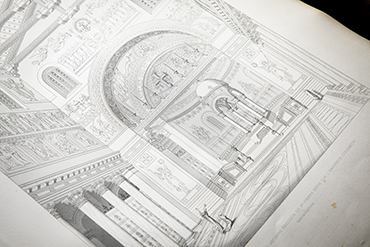 ARCHITECTURE
ARCHITECTUREArchitectural education at Utah Valley University is pursued through obtaining one or more of the following two degrees:
Students begin with the A.S. degree to build a solid foundation in architectural drafting and design. Once completed, the A.S. degree allows a student to pursue entry level employment as a drafter in the architectural industry. Students should anticipate a minimum of two years of study to obtain this degree. Upon completion of the A.S. degree, students are eligible to matriculate into the Bachelor of Architecture degree program. Students interested in practicing architecture as a licensed professional, should enroll in the B-Arch degree program. Students should anticipate a minimum of three years of study beyond the A.S. degree to obtain the B-Arch. In total, students should expect a minimum of five years of education to obtain both the A.S. and B-Arch degrees.
First year students are given a solid foundation in classical architecture and theory. Beginning in the foundations of Classical Architecture Workshop (ARC 1010), students learn about timeless design principles, patterns, proportions, sacred geometry, and spatial relationships inherent in nature and how to apply them to design problems. Second-year design studios (ARC 2110, ARC 2210) continue to build upon this foundation as students apply the classical orders to a series of projects investigating the relationships of space, form, site, and context. All three design-based courses deal with the fundamental level of design where natural and formal ordering systems are applied to two and three-dimensional design problems. Included in these first two years are also several courses focused on increasing the technical skills of students. From architectural drafting and modeling to applied structures, materials, specifications, and construction documents, students cultivate practice-ready skill sets as demonstrated by receiving their Construction Documents Technology (CDT) certification through CSI. At the termination of the first two years of coursework, students are awarded an Associate of Science in Engineering Design Technology (Architectural Design & Drafting Track) degree.
Third-year students embark further into an investigative design process that is rigorous yet open to inquiry. Design studios begin to explore issues dealing with assessing user and client needs through programming, addressing relevant building codes, and responding to different historical and urban contexts. Students are taught that buildings must not be ignorant of their context but rather adopt a cultural sensitivity or anthropological perspective regarding the spirit of the place. As a result, students learn how to honor the culture, tradition, memory, and history of a place. Students also learn how sustainable design strategies are affected by climate, site, and building typology. Supplemental coursework in Environmental Systems (ARC 3220; ARC 4120), Codes and Construction law (ARC 3130), Architectural Graphic Communications (ARC 3120), a second course in Applied Structural Systems (EGDT 2610), and Global Architectural History to 1700 (ARC 3230) help students understand the interconnected and increasingly complex problems inherent in architectural design.
In the fourth-year, students address increasingly complex systems on the building integration design level in studio (ARC 4110, ARC 4210). Students learn how to integrate structural, mechanical, electrical, acoustical, environmental, building enclosure, and life safety systems into their designs. Students also begin to grapple with the ethical function and aesthetics of architecture by understanding the built environment's effect on human perception, behavior, emotion, and cognition. As in earlier design studios, precedent analysis is a vital part of the design process. Students are able to build upon the best ideas of the past, give authority and meaning to their own designs, avoid mistakes by learning how their predecessors solved problems, and design sensitively by relating their proposal to existing contexts. Supplemental coursework includes Architectural Theory (ARC 4520), Global Architectural History from 1700 (ARC 4130), Culture and Behavior in Architecture (ARC 4530), and Building Envelope Science (ARC 4220). It is also after the fourth year that students are given opportunities to study abroad in the summer.
Fifth-year students explore urban design and planning issues on an investigative level during the first semester design studio (ARC 4510). It is during this final year that students also practice their research skills through the independent senior capstone project (ARC 4230) where they develop an architectural building program, assess client-user needs, select and analyze a project site including its context and historic fabric in preparation for their design proposal. Students demonstrate their comprehensive understanding of building systems in a final integrative architectural design studio (ARC 4610). This capstone studio project is designed for the student to fully integrate environmental systems, life-safety, accessibility, structural systems, building envelope, and site considerations. Students take a professional services practicum course during the fifth year to prepare them for Professional Practice (ARC 4540). It is through the combination of research and design methods that students leave the program prepared to address the demands of 21st-century practice.
 Learn More
Learn More